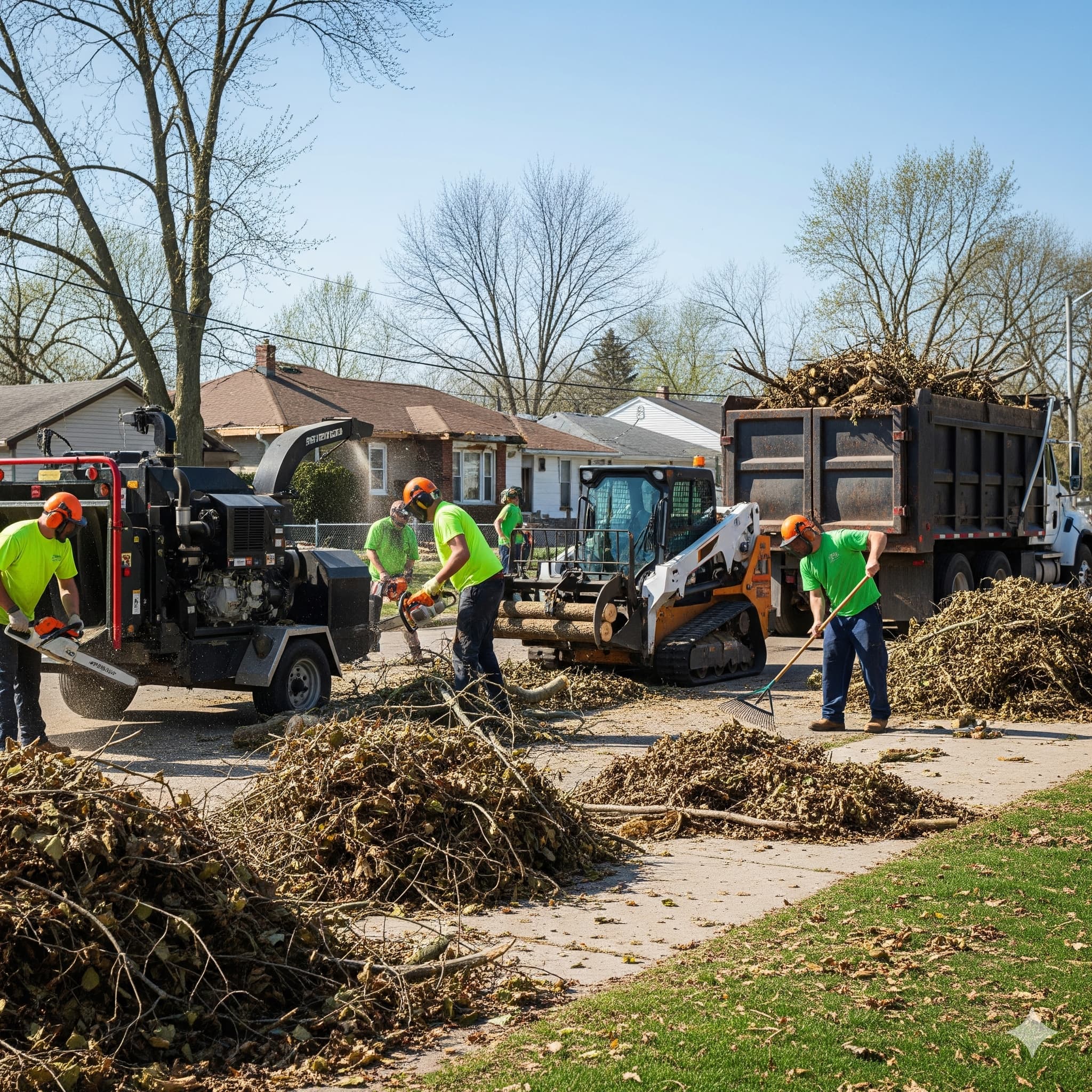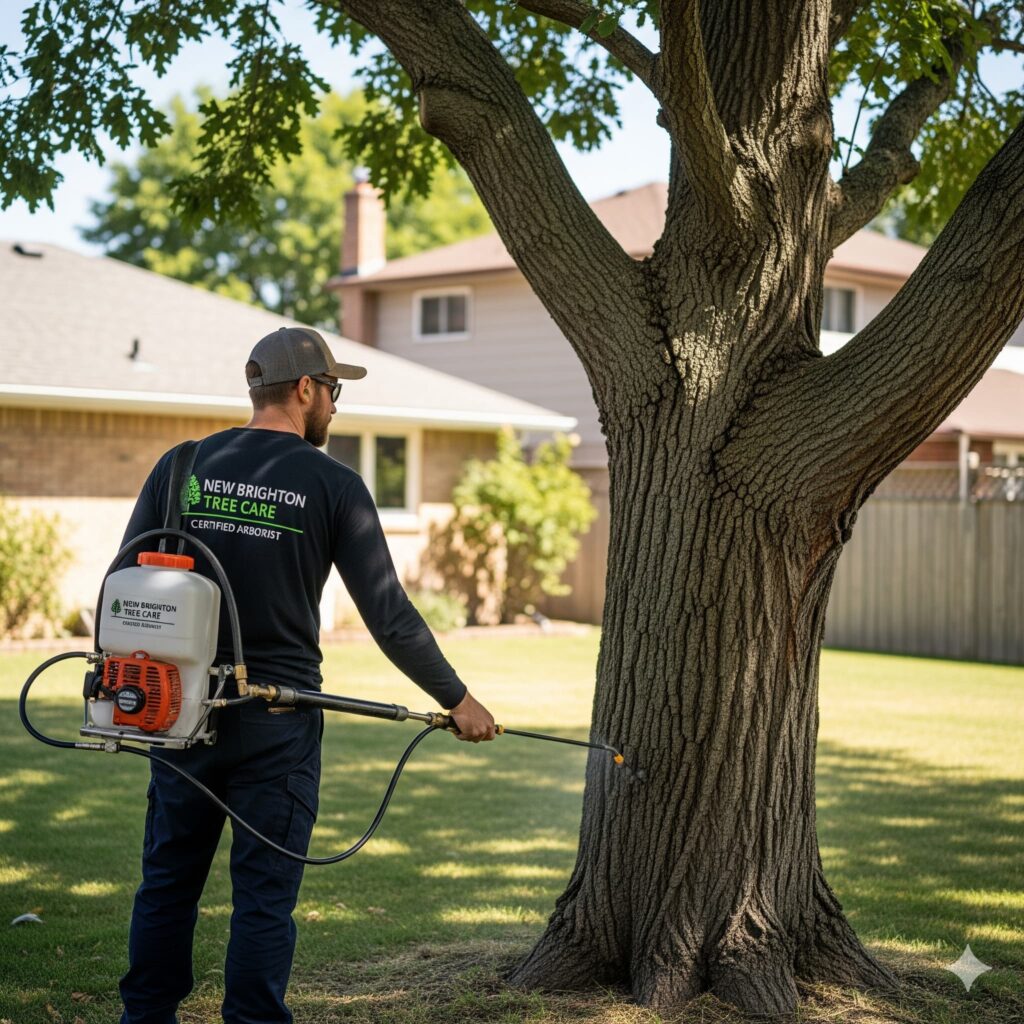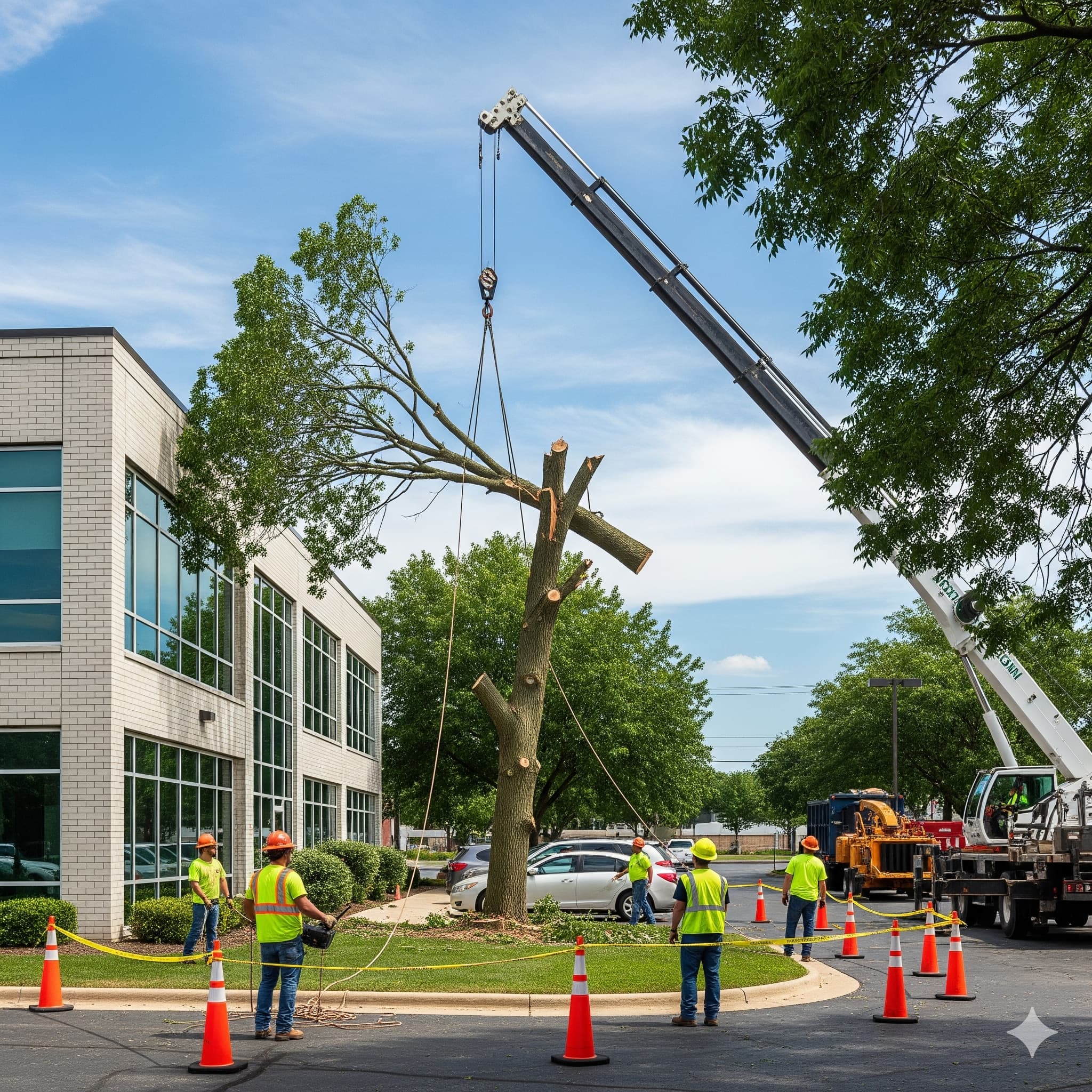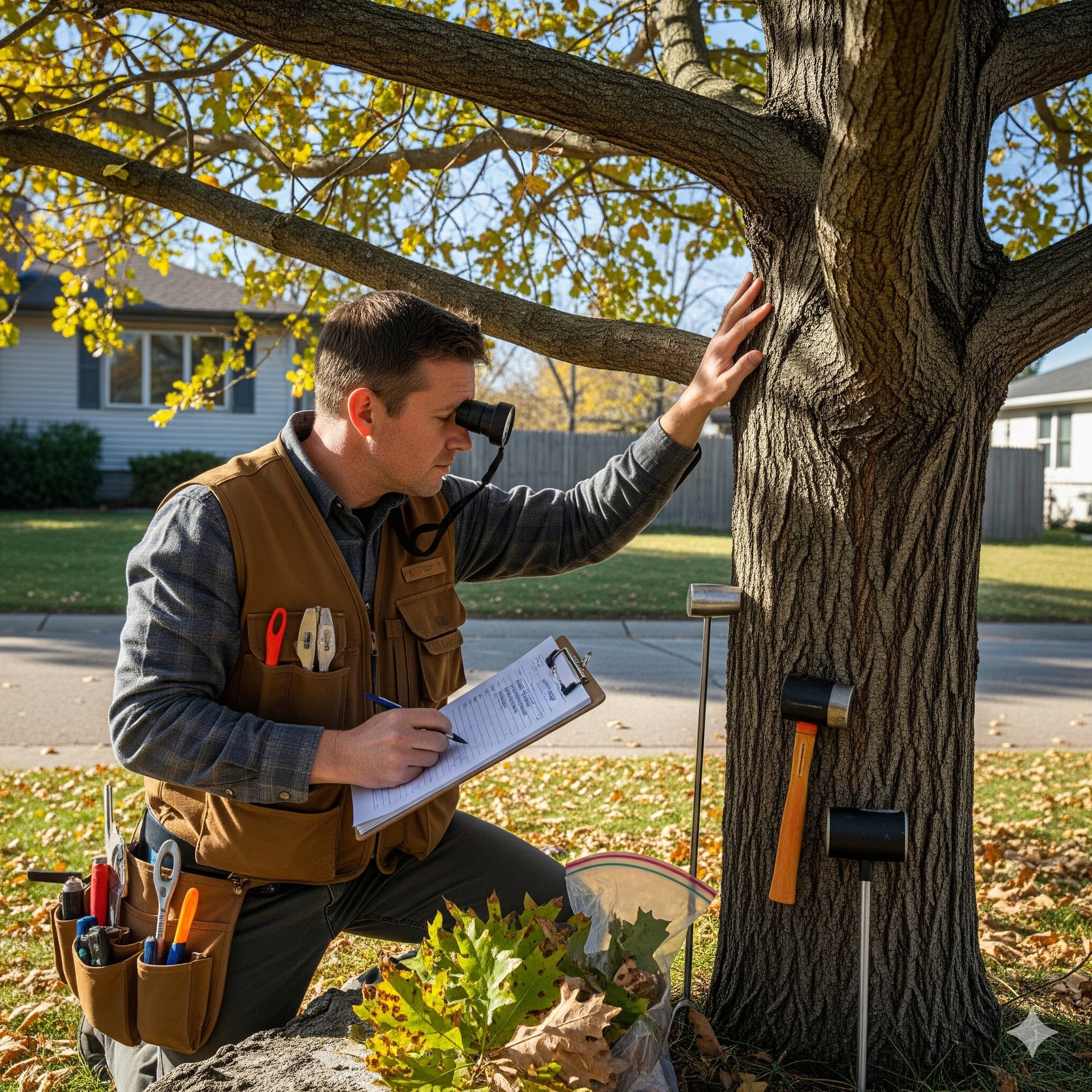
Tree Disease Treatment: IPM Solutions in New Brighton
Tree Disease Treatment New Brighton
Integrated Pest Management (IPM) approaches to tree disease treatment provide effective, environmentally responsible solutions for maintaining tree health throughout New Brighton, Minnesota. At Majestic Tree Services New Brighton, we implement comprehensive IPM strategies that combine prevention, monitoring, and targeted treatments to protect trees from the Historic New Brighton depot area to the recreational spaces around Long Lake Regional Park.

Understanding Integrated Pest Management for Trees
Integrated Pest Management (IPM) represents a holistic approach to tree disease treatment that emphasizes prevention, early detection, and targeted intervention using the least toxic methods effective for each situation. This approach reduces reliance on chemical treatments while providing effective disease control that protects both tree health and environmental quality.
IPM strategies consider tree biology, disease life cycles, environmental factors, and human activity impacts to develop comprehensive management programs that address root causes of disease problems rather than just treating symptoms.
Common Tree Diseases in New Brighton
Oak Wilt Management
Oak wilt remains one of the most serious tree diseases affecting New Brighton’s valuable oak population. IPM approaches to oak wilt include prevention through proper pruning timing, early detection through regular monitoring, and targeted treatments including root graft disruption and fungicide applications where appropriate.
Preventive measures form the foundation of oak wilt IPM, including educating property owners about pruning timing restrictions and wound treatment requirements during high-risk periods when sap beetles transmit the disease.
Dutch Elm Disease Control
Dutch elm disease management requires integrated approaches combining sanitation, vector control, and preventive treatments. IPM strategies focus on eliminating breeding sites for elm bark beetles while protecting valuable elm trees through preventive fungicide applications.
Early detection and rapid response are critical components of Dutch elm disease IPM, requiring regular monitoring and immediate action when symptoms appear to prevent disease spread throughout elm populations.
Emerald Ash Borer Response
While Emerald Ash Borer (EAB) continues to affect ash trees throughout New Brighton, IPM approaches focus on protecting high-value trees through preventive treatments while managing infested trees appropriately to reduce beetle populations.
EAB management integrates biological controls, chemical treatments for valuable trees, and sanitation measures to reduce overall beetle populations while protecting the most important ash trees in the community.
IPM Treatment Strategies
Cultural Controls and Prevention
Cultural control methods form the foundation of IPM disease treatment programs. These practices include proper watering, mulching, pruning, and site management that promote tree health and reduce disease susceptibility.
Preventive cultural practices specific to New Brighton conditions include managing soil moisture during drought periods, proper mulching to reduce stress, and maintaining appropriate clearances around trees to improve air circulation and reduce disease pressure.
Biological Control Integration
Biological controls utilize natural enemies of disease pathogens and insect vectors to provide sustainable, long-term management solutions. These approaches work with natural ecological processes to maintain disease levels below damaging thresholds.
Biological control strategies include encouraging beneficial organisms, using biological fungicides where appropriate, and managing ecosystems to support natural disease suppression mechanisms.
Targeted Chemical Applications
When prevention and biological controls are insufficient, IPM programs incorporate targeted chemical treatments applied at optimal timing for maximum effectiveness with minimum environmental impact. Chemical treatments are selected based on specific disease identification and environmental considerations.
Targeted applications focus on protecting high-value trees, preventing disease spread during critical periods, and using the most selective materials available that effectively control diseases while minimizing non-target impacts.
Disease Monitoring and Early Detection
Effective IPM programs rely on systematic monitoring and early detection to identify disease problems before they become severe. Regular tree health assessment allows for timely intervention using less intensive management methods.
Professional monitoring includes seasonal surveys, trap monitoring for insect vectors, and systematic evaluation of tree health indicators that provide early warning of developing disease problems.
Diagnostic Services and Confirmation
Accurate disease diagnosis is essential for effective IPM implementation. Professional diagnostic services ensure that treatments target specific disease problems rather than addressing symptoms that might have multiple causes.
Laboratory confirmation of disease identification supports precise treatment selection and helps avoid unnecessary or ineffective treatments that waste resources and potentially harm tree health.
Site-Specific Treatment Planning
IPM strategies are customized for specific sites and tree populations based on species composition, environmental conditions, disease history, and management objectives. Site-specific planning ensures that treatments address local conditions and priority concerns.
Treatment planning for New Brighton locations considers factors including soil conditions, microclimate, tree species diversity, and human activity patterns that influence disease development and management options.
Risk Assessment and Priority Setting
IPM programs prioritize management actions based on risk assessment that considers disease severity, tree value, spread potential, and treatment effectiveness. This approach allocates resources efficiently while addressing the most critical disease problems first.
Priority setting helps property owners focus management efforts on trees and disease problems where treatment will provide the greatest benefit for the investment made in disease control measures.
Environmental Considerations
IPM approaches emphasize environmental responsibility by minimizing chemical usage, protecting non-target organisms, and supporting ecosystem health. These considerations are particularly important in urban environments where people, pets, and wildlife interact closely with treated areas.
Environmental protection measures include selecting the least-toxic effective treatments, timing applications to minimize impacts, and using application methods that reduce drift and environmental exposure.
Water Quality Protection
Tree disease treatments near waterways, including areas around Long Lake and other water features in New Brighton, require special consideration to protect water quality. IPM strategies incorporate buffer zones and application restrictions that prevent contamination.
Water quality protection measures include selecting treatments with minimal water solubility, avoiding applications during weather conditions that increase runoff risk, and implementing buffer zones around sensitive water features.
Treatment Timing and Scheduling
Effective IPM requires precise timing of treatments based on disease life cycles, vector activity patterns, and tree physiology. Proper timing maximizes treatment effectiveness while minimizing environmental impact and cost.
Treatment scheduling considers seasonal factors, weather conditions, and tree stress levels to ensure applications provide maximum benefit while supporting overall tree health.
Seasonal Treatment Programs
Many tree diseases require seasonal treatment programs that address different life cycle stages or provide ongoing protection during vulnerable periods. Seasonal programs integrate multiple treatment approaches for comprehensive disease management.
Long-term treatment schedules help property owners plan for ongoing disease management costs while ensuring continuous protection for valuable trees throughout critical periods.
Treatment Effectiveness Evaluation
IPM programs include systematic evaluation of treatment effectiveness to ensure management objectives are being met and to identify necessary program adjustments. Regular evaluation helps optimize treatment strategies over time.
Effectiveness evaluation includes monitoring treated trees for disease progression, assessing treatment impacts on tree health, and documenting changes in disease pressure that indicate program success or needed modifications.
Professional IPM Implementation
Successful IPM programs require professional expertise in disease identification, treatment selection, application timing, and program evaluation. Professional implementation ensures that IPM strategies are properly designed and executed for maximum effectiveness.
We provide comprehensive IPM-based tree disease treatment services throughout New Brighton, integrating prevention, monitoring, and targeted treatments that protect tree health while minimizing environmental impact. Our approach emphasizes sustainable, long-term solutions that maintain New Brighton’s valuable urban forest.
IPM approaches to tree disease treatment provide effective, environmentally responsible solutions for protecting New Brighton’s trees. Trust professional services that understand IPM principles and can implement comprehensive disease management programs tailored to local conditions and specific tree health needs.



